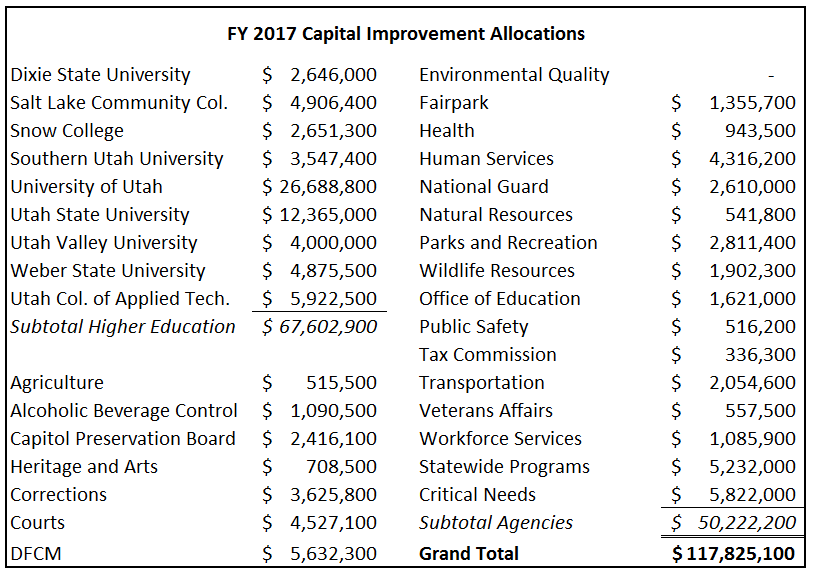Fiscal Highlights - June 2016
|
FY 2017 Capital Improvement Allocations -
Angela J. Oh ( The State of Utah has a statutory requirement to fund capital improvements and it is one of the few states that uses ongoing appropriations to do so. The 2016 Legislature appropriated almost $118 million to the Capital Budget line item for capital improvements. Current law, UCA 63A-5-104(7), requires capital improvement funding to be 1.1 percent of combined building values before the State can build any new buildings. During budget deficits, statute allows funding to fall below the 1.1 percent replacement value to 0.9 percent without additional statutory changes. Prior to the 2016 General Session, capital improvements, formerly known as alterations, repairs, and improvements (AR and I), consisted of projects costing less than $2.5 million to improve an existing facility or less than $500,000 to construct a new facility. S.B. 156, "State Facilities Amendments," amends the thresholds for capital improvement (and capital development funding) so capital improvements are now $3.5 million or less to remodel, alter, replace, or repair a project; or $3.5 million or less for a site or utility improvement. This change allows for projects that would have been considered capital development projects to now be considered capital improvements. The Division of Facilities Construction and Management, under the direction of the State Building Board, uses capital improvement funds to make critical repairs to state facilities and replace worn equipment. Typical improvement projects include repairs to utility tunnels, HVAC systems, electrical systems, roofs, and parking lots. The table below shows the FY 2017 allocation of capital improvements approved by the State Building Board.  |
Cost to Transfer UACD Employees to Agriculture - Ivan D. Djambov The purpose of this article is to provide background information about the Department of Agricult...Department of Environmental Quality Fees - Brian Wikle UCA 63J-1-504 requires that each fee assessed by an agency be "reasonable, fair, and reflect the co...Equipment Funding Allocations for the Utah College of Applied Technology - Jill L.Curry The Utah College of Applied Technology (UCAT) receives funding for equipment at its eight colleges...Funding for Utah's Veterans' Nursing Homes - Steven M. Allred The State operates four veterans nursing homes located in Salt Lake City, Ogden, Payson, and Ivins....FY 2017 Capital Improvement Allocations - Angela J. Oh The State of Utah has a statutory requirement to fund capital improvements and it is one of the f...Market-Based Billing for State Audits - Clare Tobin Lence During the 2014 General Session, the Legislature passed intent language supporting the State Audi...Revenue Update - Fiscal Highlights - June 2016 - Andrea Wilko Utah's revenue is expected to grow by 3.0 percent between FY 2015 and FY 2016. We anticipate collec...School Funding Equalization - Ben Leishman Utah is continually ranked as one of the most equalized states in the nation when it comes to fun...The Price of Gas: More Driving and an Industry Recession - Thomas E. Young One of the more transparent price movements in recent years is the drop in the price of gasoline. T...USHE Enrollment Projections - Spencer C. Pratt The Utah State Board of Regents recently adopted enrollment projections for the eight colleges and ...What Happened at the June 16, 2016 Meeting of the Social Services Appropriations Subcommittee? - Russell T. Frandsen Morning AgendaCall to Order /Approval of MinutesSubcommittee Questions from the 2016 General Sessio... |
Reports/Archive | Budget Process | Office Background | Who's Who | Organization Chart
Office of the Legislative
Fiscal Analyst
House Building, Suite W310
Salt Lake City, UT 84114
Phone (801) 538-1034 Fax (801) 538-1692